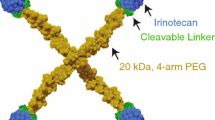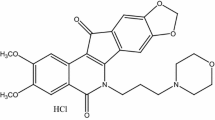Abstract
Purpose
A variety of anticancer drugs, including doxorubicin and mitoxantrone, have structures in which a DNA-intercalating chromophore is linked to a positively charged side chain. These drugs generally inhibit tumour growth and survival by poisoning the enzyme DNA topoisomerase II. SN 28049, a benzonaphthyridine derivative with these properties, has curative activity against the Colon 38 tumour in mice. Previous pharmacokinetic studies have demonstrated tumour-selective retention with approximately 20-fold higher area under the concentration–time curve (AUC) for tumour tissue as compared to normal tissues. We have investigated here whether such retention is tumour specific.
Methods
Plasma and tissue pharmacokinetics were assessed in the murine Lewis lung (LL3) tumour in C57 BL/6 mice and in xenografts of the NZM4, NZM10 and NZM52 human melanoma lines in Balb/c Rag-1 immunodeficient mice. The in vitro cellular localisation of SN 28049 in murine and human cell lines was studied by confocal fluorescence microscopy.
Results
A 260-fold variation, from 8.9 μM h (NZM4) to 2,334 μM h (Colon 38), was found among the different tumours. Only small variations were observed in the corresponding plasma AUC (2.9–5 μM h). Moreover, in vivo activity, as measured by tumour growth delay, varied from 1 day (NZM4) to curative (Colon 38), consistent with the tumour pharmacokinetic data. In cultured cell lines, SN 28049 was found in cytoplasmic bodies, suggesting that drug sequestration could contribute to tumour pharmacokinetics.
Conclusion
SN 28049 shows dramatic differences in both tumour AUC and antitumour activity against different tumours. These differences point to the presence of a tumour-specific uptake and retention mechanism.






Similar content being viewed by others
References
Nelson EM, Tewey K, Liu LF (1984) Mechanism of antitumor drug action: poisoning of mammalian DNA topoisomerase II on DNA by 4′-(9-acridinylamino)-methanesulfon-m-anisidide. Proc Natl Acad Sci USA 81:1361–1365
Tewey KM, Rowe TC, Yang L, Halligan BD, Liu LF (1984) Adriamycin-induced DNA damage mediated by mammalian DNA topoisomerase II. Science 226:466–468
Arcamone F (1985) Properties of antitumor anthracyclines and new developments in their application: Cain Memorial Award Lecture. Cancer Res 45:5995–5999
Martini A, Donelli NG, Mantovani A, Pacciarini MA, Fogar-Ottaviano EF, Morasca L, Garattini S, Spreafico FS (1977) Antineoplastic activity and pharmacokinetics of adriamycin and daunomycin in tumor bearing mice. Oncology 34:173–178
Arlin ZA (1983) Current status of amsacrine (AMSA) combination chemotherapy programs in acute leukemia. Cancer Treat Rep 67:967–970
Baguley BC, Kernohan AR, Wilson WR (1983) Divergent activity of derivatives of amsacrine (m-AMSA) towards Lewis lung carcinoma and P388 leukaemia in mice. Eur J Cancer Clin Oncol 19:1607–1613
Finlay GJ, Riou JF, Baguley BC (1996) From amsacrine to DACA (N-[2-(dimethylamino)ethyl]acridine-4-carboxamide): selectivity for topoisomerases I and II among acridine derivatives. Eur J Cancer 32A:708–714
Deady LW, Rodemann T, Zhuang L, Baguley BC, Denny WA (2003) Synthesis and cytotoxic activity of carboxamide derivatives of benzo[b][1, 6]naphthyridines. J Med Chem 46:1049–1054
Bu X, Chen J, Deady LW, Smith CL, Baguley BC, Greenhalgh D, Yang S, Denny WA (2005) Synthesis and cytotoxic activity of N-[(alkylamino)alkyl]-carboxamide derivatives of 7-oxo-7H-benz[de]anthracene,7-oxo-7H-naphtho[1,2,3-de]quinoline, and 7-oxo-7H-benzo[e]perimidine. Bioorg Med Chem 13:3657–3665
Deady LW, Rogers ML, Zhuang L, Baguley BC, Denny WA (2005) Synthesis and cytotoxic activity of carboxamide derivatives of benzo[b][1, 6]naphthyridin-(5H)ones. Bioorg Med Chem 13:1341–1355
Chen YY, Finlay GJ, Kirker JA, Marshall ES, Richardson E, Baguley BC (2011) In vivo and in vitro assessment of the action of SN 28049, a benzonaphthyridine derivative targeting topoisomerase II, on the murine Colon 38 carcinoma. Invest New Drugs 29:1504–1510
Drummond CJ, Finlay GJ, Broome L, Marshall ES, Richardson E, Baguley BC (2011) Action of SN 28049, a new DNA binding topoisomerase II-directed antitumour drug: comparison with doxorubicin and etoposide. Invest New Drugs 29:1102–1110
Lukka PB, Paxton JW, Kestell P, Baguley BC (2010) Pharmacokinetics and distribution of SN 28049, a novel DNA binding anticancer agent, in mice. Cancer Chemother Pharmacol 65:1145–1152
Lukka PB, Paxton JW, Kestell P, Baguley BC (2012) Comparison of a homologous series of benzonaphthyridine anti-cancer agents in mice: divergence between tumour and plasma pharmacokinetics. Cancer Chemother Pharmacol 70:151–160
Baguley BC, Zhuang L, Marshall E (1995) Experimental solid tumour activity of N-[2-(dimethylamino)ethyl]- acridine-4-carboxamide. Cancer Chemother Pharmacol 36:244–248
Wilkoff LJ, Dulmadge E, Chopra DP (1980) Viability of cultured Lewis lung cell populations exposed to beta-retinoic acid (40753). Proc Soc Exp Biol Med 163:233–236
Marshall ES, Finlay GJ, Matthews JH, Shaw JH, Nixon J, Baguley BC (1992) Microculture-based chemosensitivity testing: a feasibility study comparing freshly explanted human melanoma cells with human melanoma cell lines. J Natl Cancer Inst 84:340–345
Marshall ES, Holdaway KM, Shaw JH, Finlay GJ, Matthews JH, Baguley BC (1993) Anticancer drug sensitivity profiles of new and established melanoma cell lines. Oncol Res 5:301–309
Kim JE, Stones C, Joseph WR, Leung E, Finlay GJ, Shelling AN, Phillips WA, Shepherd PR, Baguley BC (2012) Comparison of growth factor signalling pathway utilisation in cultured normal melanocytes and melanoma cell lines. BMC Cancer 12:141
Workman P, Aboagye EO, Balkwill F, Balmain A, Bruder G, Chaplin DJ, Double JA, Everitt J, Farningham DA, Glennie MJ, Kelland LR, Robinson V, Stratford IJ, Tozer GM, Watson S, Wedge SR, Eccles SA (2010) Guidelines for the welfare and use of animals in cancer research. Br J Cancer 102:1555–1577
Lukka PB, Paxton JW, Atwell GJ, Kestell P, Baguley BC (2012) A rapid LC-MS/MS method for the quantitation of a series of benzonaphthyridine derivatives: application to in vivo pharmacokinetic and lipophilicity studies in drug development. J Pharm Biomed Anal 63:9–16
Hicks KO, Pruijn FB, Baguley BC, Wilson WR (2001) Extravascular transport of the DNA intercalator and topoisomerase poison N-[2-(dimethylamino)ethyl]acridine-4-carboxamide (DACA): diffusion and metabolism in multicellular layers of tumor cells. J Pharmacol Exp Ther 297:1088–1098
Shinkai H, Takahashi H, Miyamoto K, Uchida T, Tokiwa T (1996) Comparative pharmacokinetics of KRN8602, a new morpholino anthracycline, and adriamycin in tumor-bearing mice. Cancer Chemother Pharmacol 38:417–424
Balkwill F (2004) Cancer and the chemokine network. Nat Rev Cancer 4:540–550
Morgan ET, Goralski KB, Piquette-Miller M, Renton KW, Robertson GR, Chaluvadi MR, Charles KA, Clarke SJ, Kacevska M, Liddle C, Richardson TA, Sharma R, Sinal CJ (2008) Regulation of drug-metabolizing enzymes and transporters in infection, inflammation, and cancer. Drug Metab Dispos 36:205–216
Fardel O, Le Vee M (2009) Regulation of human hepatic drug transporter expression by pro-inflammatory cytokines. Expert Opin Drug Metab Toxicol 5:1469–1481
Bour-Dill C, Gramain MP, Merlin JL, Marchal S, Guillemin F (2000) Determination of intracellular organelles implicated in daunorubicin cytoplasmic sequestration in multidrug-resistant MCF-7 cells using fluorescence microscopy image analysis. Cytometry 39:16–25
Chikamori K, Grozav AG, Kozuki T, Grabowski D, Ganapathi R, Ganapathi MK (2010) DNA topoisomerase II enzymes as molecular targets for cancer chemotherapy. Curr Cancer Drug Targets 10:758–771
Goldenberg GJ, Vanstone CL, Bihler L (1971) Transport of nitrogen mustard on the transport carrier for choline in L5178Y lymphoblasts. Science 172:1148–1149
Okabe M, Szakacs G, Reimers MA, Suzuki T, Hall MD, Abe T, Weinstein JN, Gottesman MM (2008) Profiling SLCO and SLC22 genes in the NCI-60 cancer cell lines to identify drug uptake transporters. Mol Cancer Ther 7:3081–3091
Acknowledgments
This study was supported by the Auckland Cancer Society and by a grant from Auckland UniServices Ltd., New Zealand.
Conflict of interest
None.
Author information
Authors and Affiliations
Corresponding author
Rights and permissions
About this article
Cite this article
Lukka, P.B., Chen, Y.Y., Finlay, G.J. et al. Tumour tissue selectivity in the uptake and retention of SN 28049, a new topoisomerase II-directed anticancer agent. Cancer Chemother Pharmacol 72, 1013–1022 (2013). https://doi.org/10.1007/s00280-013-2280-0
Received:
Accepted:
Published:
Issue Date:
DOI: https://doi.org/10.1007/s00280-013-2280-0




